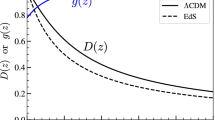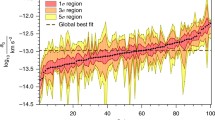Abstract
COSMIC structure is thought to have arisen by the gravitational amplification of small density fluctuations in the early Universe. The evolution of fluctuations with specified magnitude and spectrum is controlled by a few fundamental parameters: the cosmic density Ω, the cosmological constant Λ, and the relative contributions of radiation and of dark and visible matter to the density of the Universe. Maps and statistical descriptions of the large-scale distribution of galaxies, from the QDOT IRAS redshift survey1–7, along with the COBE measurements of the microwave background fluctuations8,9 have recently transformed our understanding of large-scale structure, for which the growth of fluctuations is linear and well understood. These two sets of data effectively determine the density fluctuation spectrum in the present Universe on scales from 10 to 1,000 Mpc. Here we examine an array of structure formation models, and show that most are ruled out by the COBE and QDOT observations. We find only one completely satisfactory model, in which the Universe has density Ω = 1, with 69% in the form of cold dark matter, 30% provided by hot dark matter in the form of a stable neutrino with mass 7.5 eV, and 1% baryonic. Certain 'grand unified theories'10,11 may provide a physical basis for such, hybrid models. A Hubble constant of 50 km s−1 Mpc−1 is preferred to one of 100.
Similar content being viewed by others
References
Rowan-Robinson, M. et al. Mon. Not. R. astr. Soc. 247, 1–18 (1990).
Efstathiou, G. et al. Mon. Not. R. astr. Soc. 247, 10p–14p (1990).
Saunders, W. et al. Nature 349, 32–38 (1991).
Kaiser, N. et al. Mon. Not. R. astr. Soc. 252, 1–12 (1991).
Moore, B. et al. Mon. Not. R. astr. Soc. 256, 471–499 (1991).
Saunders, W., Rowan-Robinson, M. & Lawrence, A. Mon. Not. R. astr. Soc. (in the press).
Taylor, A. N. & Rowan-Robinson, M. Mon. Not. R. astr. Soc. (submitted).
Wright, E. L. et al. Astrophys. J. (in the press).
Smoot, G. F. et al. Astrophys. J. (submitted).
Shafi, Q. & Stecker, F. W. Phys. Rev. Lett. 53, 1292–1295 (1984).
Schaefer, R. K., Shafi, Q. & Stecker, F. W. Astrophys. J. 347, 575–589 (1989).
Sachs, R. K. & Wolfe, A. M. Astrophys. J. 147, 73–80 (1967).
Abramowitz, M. & Stegun, I. A. Handbook of Mathematical Functions (Dover, New York, 1965).
Hawking, S. W. Phys. Lett. B115, 295–297 (1982).
Starobinsky, A. A. Phys. Lett. B117, 175–178 (1982).
Fukugita, M. & Kawasaki, M. Astrophys. J. 353, 384–398 (1990).
Kaiser, N. Astrophys. J. 284, L9–L12 (1984).
Davis, M., Efstathiou, G., Frenk, C. S. & White, S. D. M. Astrophys. J. 292, 371–394 (1985).
Bardeen, J. M., Bond, J. R., Kaiser, N. & Szalay, A. S. Astrophys. J. 304, 15–61 (1986).
Peacock, J. A. Mon. Not. R. astr. Soc. 253, lp–5p (1991).
Taylor, A. N. thesis, Univ. London (1992).
Kaiser, N. Mon. Not. R. astr. Soc. 227, 1–21 (1987).
Maddox, S. J., Efstathiou, G., Sutherland, W. J. & Loveday, J. Mon. Not. R. astr. Soc. 242, 43p–46p (1990).
Peacock, J. A. & Nicholson, D. Mon. Not. R. astr. Soc. 253, 307–319 (1991).
Bertschinger, E., Dekel, A., Faber, S. M., Dressler, D. & Burstein, D. Astrophys. J. 364, 370–395 (1990).
Harrison, E. R. Phys. Rev. D1, 2726–2731 (1970).
Zeldovich, Y. B. Mon. Not. R. astr. Soc. 160, lp–3p (1972).
Holtzmann, J. A. Astrophys. J. 71, 1–24 (1989).
Strauss, M., Davis, M., Yahil, A. & Huchra, J. P. Astrophys. J. 361, 49–62 (1990).
Strauss, M., Yahil, A., Davis, M., Huchra, J. P. & Fisher, K. Astrophys. J. (in the press).
Turok, N. in Proc. Nobel Symp. 79 (eds Nilsson, J. S., Gustafsson, B. & Shaperstaw, B. S.) Phys. Script. T36, 135–146 (1991).
Efstathiou, G. & Bond, J. R. Mon. Not. R. astr. Soc. 218, 103–121 (1986).
White, S. D. M., Frenk, C. S. & Davis, M. Astrophys. J. 274, L1–L5 (1983).
Efstathiou, G., Sutherland, W. J. & Maddox, S. J. Nature 348, 705–707 (1990).
Efstathiou, G., Bond, J. R. & White, S. D. M. Mon. Not. R. astr. Soc. (submitted).
Carlberg, R. G., Couchman, H. M. P. & Thomas, P. A. Astrophys. J. 352, L29–L32 (1990).
Couchman, H. M. P. & Carlberg, R. G. Astrophys. J. 389, 453–463 (1992).
Kolb, E. W. & Turner, M. S. The Early Universe (Addison-Wesley, Redwood City, California, 1990).
Author information
Authors and Affiliations
Rights and permissions
About this article
Cite this article
Taylor, A., Rowan-Robinson, M. The spectrum of cosmological density fluctuations and nature of dark matter. Nature 359, 396–399 (1992). https://doi.org/10.1038/359396a0
Received:
Accepted:
Issue Date:
DOI: https://doi.org/10.1038/359396a0
- Springer Nature Limited
This article is cited by
-
A large scale double beta and dark matter experiment: GENIUS
Zeitschrift für Physik A Hadrons and Nuclei (1997)
-
Futurev τ oscillation experiments and present data
Zeitschrift für Physik C: Particles and Fields (1996)
-
Researches on dark matter
La Rivista del Nuovo Cimento (1995)
-
Oscillating neutrinos: theory vs experiment
Pramana (1995)
-
Direct observation of structure in the cosmic microwave background
Nature (1994)





